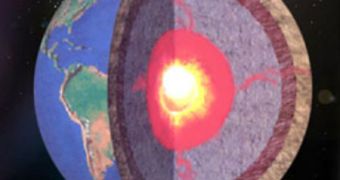A new geological theory gives rise to the belief that our planet has two inner cores instead of one, as scientists believed until now. That's not to say that the new theory proved correct. In fact, it's very difficult to say what exactly lies at the center of the Earth, as studying the region is nearly impossible. Murray State University experts Haluk Cetin and Fugen Ozkirim say that the second core could have been transferred from a collision with a Mars-sized object, in an impact so catastrophic that the debris gave birth to the Moon.
Estimated to have happened some 4.45 billion years ago, the giant object – either a small planet or a large asteroid – is believed to have hit the Earth so hard that its core sank into our planet's inner region, where it still revolves today, alongside our own. Such a deep penetration would have been possible, other geologists say, because at the time Earth was not fully solidified, but rather very hot and molten on most of its surface.
The two believe that the cores may still be there today, either spinning around each other, or together, as conjoined twins. They agree with most of the scientific community, which says that their case is highly speculative, and that there is no hard evidence to support their claims, but Cetin and Ozkirim add that this hypothesis could open up new avenues for creating models of our planet, based on completely new principles.
They also add that this type of internal make-up could explain why the Earth's core spins faster than the planet does, why Earth is hotter than normal for a planet its size, and why seismic wave propagation observations proved that the core seems to be split into two distinct areas.
Also, another interesting aspect related to their research is the possibility that two cores revolving around each other could have sparked plate tectonics. In their model, the scientists say that the two balls of molten iron spin so fast one against the other, that they suck up magma from behind them and push it forward. In time, this could create currents in the molten rock, which could make the tectonic plates on top of it collide against each other and get sucked in the undertow.
"We have no solid evidence yet, and we're not saying 100 percent that it still exists," Cetin said. "The interior of Earth is a very hard place to study. If this is true, it would change all Earth models as we know them. If not, and these two cores coalesced early on, we would have less to say, but it could still be how plate tectonics got started," he concludes.

 14 DAY TRIAL //
14 DAY TRIAL //